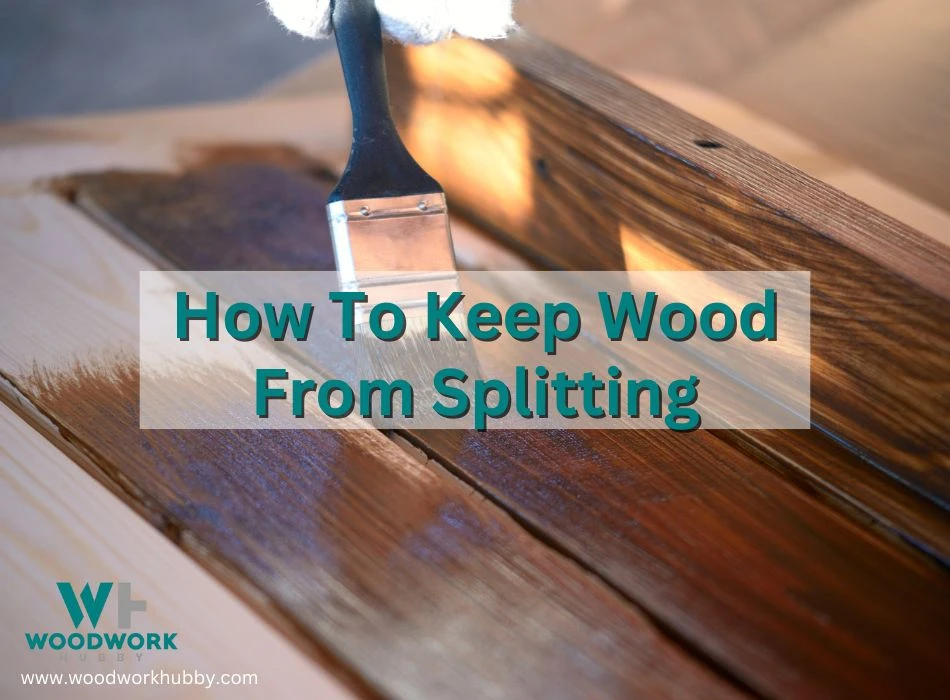I’ve noticed some of my timber slabs developed splits after I moved them into my shop. This is a common occurrence in the woodworking community so I decided to put together this guide on how to keep wood from splitting and what I did to prevent it.
This blog will guide you through proven methods, including using sealants or stabilizers and proper storage techniques, among others, all aimed at preserving your wood’s integrity. Ready to crack this problem?
Key Takeaways
- Sealing wood with a sealant or stabilizer can prevent moisture from causing splits and cracks.
- Applying boiled linseed oil creates a protective barrier that helps maintain the moisture balance in wood, reducing the risk of splitting and cracking.
- Using paintable wax or varnish as a sealant provides an additional layer of protection against moisture changes and minimizes the risk of splitting.
- Treating wood with salt paste draws out excess moisture, stabilizing its internal humidity levels and preventing splitting.
7 Methods That Work
In the world of woodworking, preventing wood from splitting and cracking is a multifaceted challenge. Through trial and error, and a lot of professional experiences under my belt, I have gathered seven effective methods to keep your wood intact for longer.
1. Use a Sealant or Stabilizer
First off, sealing with either a sealant or stabilizer can act as an efficient barrier against moisture changes that often cause splits.
2. Linseed Oil
Then there’s applying boiled linseed oil – an age-old practice favored by skilled artisans for its natural protective properties.
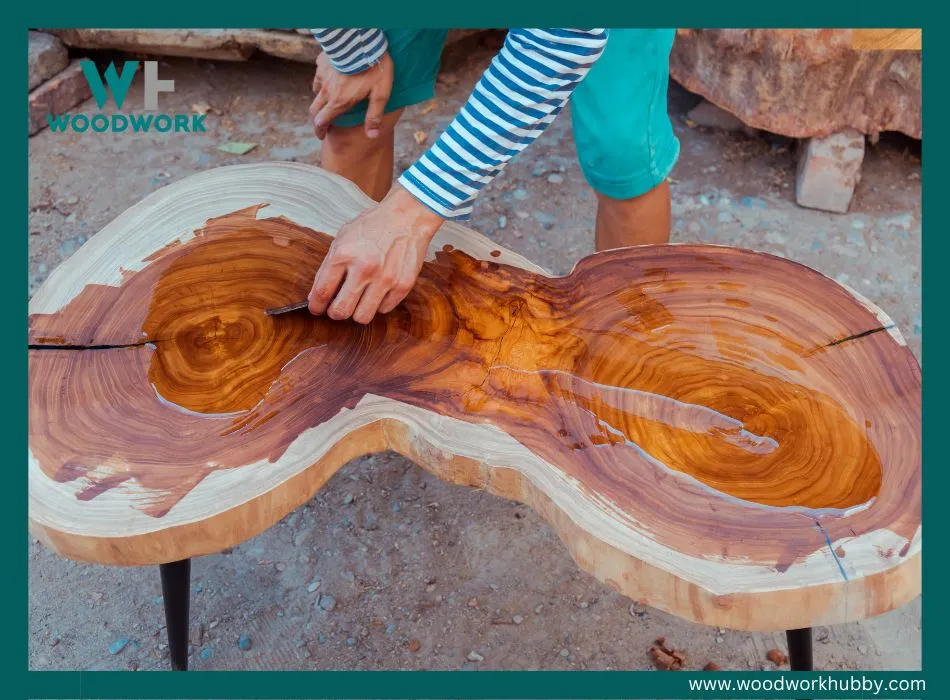
3. Paintable Wax
A thin layer not only adds gloss but also prevents cracks due to its flexible coating system that withstands expansions and contractions in humidity changes better than conventional sealants do!
4. Sealing with Varnish
Sealing with varnish gives you another added layer of protection while enhancing your woodwork’s aesthetic appeal simultaneously.
5. Salt Paste
If you’re looking for something more unconventional yet equally effective, treating the wood with salt paste might surprise you – it helps retain internal moisture thus protecting against drying out too quickly which leads to splitting.
6. Use Screws Not Nails
Using screws instead of nails on narrow board ends can also reduce tension bands which are notorious culprits for causing splits.
7. Store Your Timber Correctly
Lastly, ensuring correctly stored lumber will prevent damages attributed to high moisture content such as fungal rot and warping; ultimately preserving the structural integrity of your wood over time.
This video shows how to repair cracked wood
Understanding Wood Splitting And Cracking
Wood splitting and cracking occur due to changes in moisture content and direct impact. High moisture content can cause wood fibers to expand, while low moisture levels lead to shrinkage. This expansion and contraction can pull joints apart, resulting in splitting.

Direct impact from tools or improper nailing/screwing can also cause wood fibers to split apart. A proper understanding of these factors is crucial for preventing wood from splitting and cracking.
Moisture Content Changes
Moisture content changes are central to understanding why wood splits and cracks. It’s important for DIY enthusiasts and professional woodworkers alike to grasp this concept.
When the moisture content is high within a piece of wood, it causes expansion. Wood cells absorb water leading to swelling and an increase in size – this is when you face the risk of splitting due to excess strain from the expansion.
Conversely, if the moisture content drops too low, shrinkage troubles come into play. The severe dryness causes contraction; with minimal internal structural support for its fibers, those dreaded cracks start appearing.
Video explains how to stop cracks in wood
Direct Impact
A forceful blow to the wood can lead to splitting or cracking, owing to the disruption of its fiber pores and structure. This is particularly true for greenwood with high moisture content where the sudden impact causes a shift in internal tensions creating cracks.
Even dry wood isn’t immune – an ill-placed nail or screw can cause displacement leading to imperfections and potential splits.
How To Store Wood Properly
Properly storing wood is crucial in preventing splitting and cracking. The first step is to ensure that the wood is stored in a dry location, away from high-humidity areas such as basements or damp garages.
Moisture content plays a significant role in wood’s movement and potential for splitting. It’s best to store wood in an area where there is good airflow to allow for proper drying.
Below is an image of how I use sticks to store my timber. This allows good airflow around all pieces.
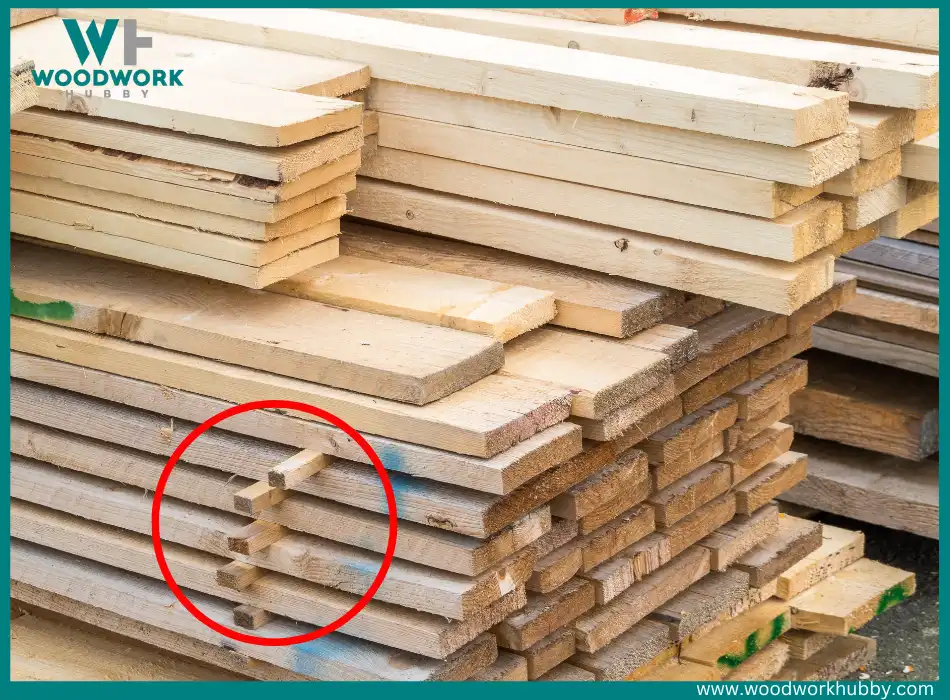
Secondly, it’s essential to stack the wood correctly. When stacking, make sure to use spacers between each board or slab to promote better airflow. This allows the moisture within the wood to evaporate evenly and prevents uneven drying that can lead to cracks.
Lastly, protect your wood from direct sunlight and extreme temperature changes. Exposure to these elements can cause rapid moisture loss, leading to warping and cracking in the long run. Using shade cloth or burlap can help shield your stored wood while still allowing air circulation.
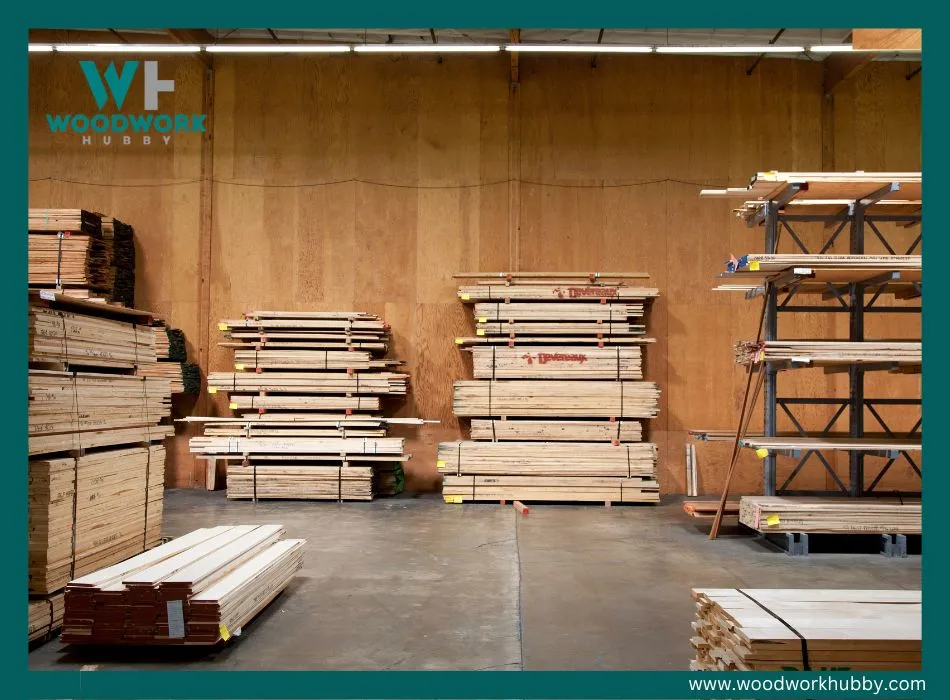
By following these storage tips, you’ll minimize the risk of splitting and cracking in your precious pieces of lumber or woodworking projects
7 Methods To Prevent Wood From Splitting
Sealing With A Sealant Or Stabilizer
One effective method to keep wood from splitting is by sealing it with a sealant or stabilizer. The sealant creates a protective barrier on the surface of the wood, preventing moisture from penetrating and causing expansion and contraction that can lead to splitting and cracking.
A good quality sealant will also prevent UV damage and inhibit the growth of mold and mildew. Additionally, using a wood stabilizer can help maintain the structural integrity of the wood by preventing warping and shifting over time.
Applying Boiled Linseed Oil
One effective method to prevent wood from splitting and cracking is by applying boiled linseed oil. Boiled linseed oil works as a sealant, penetrating deep into the wood fibers and locking in moisture.
This helps to minimize the expansion and contraction of the wood due to changes in humidity, which is a common cause of splitting. The application process is simple – just use a clean cloth or brush to evenly apply the boiled linseed oil onto your wood surface, making sure to cover all areas.
Allow it to soak in for about 15-20 minutes before wiping off any excess oil. Repeat this process two more times, allowing each coat to dry completely between applications. Finally, buff the surface with a soft cloth for optimal protection and shine.
Sealing With Paintable Wax
One effective and cost-efficient method to prevent the wood from splitting and cracking, especially in greenwood, is by sealing it with paintable wax. This process involves applying a layer of wax onto the surface of the wood, which helps to seal moisture within the fibers and reduce the drying rate.
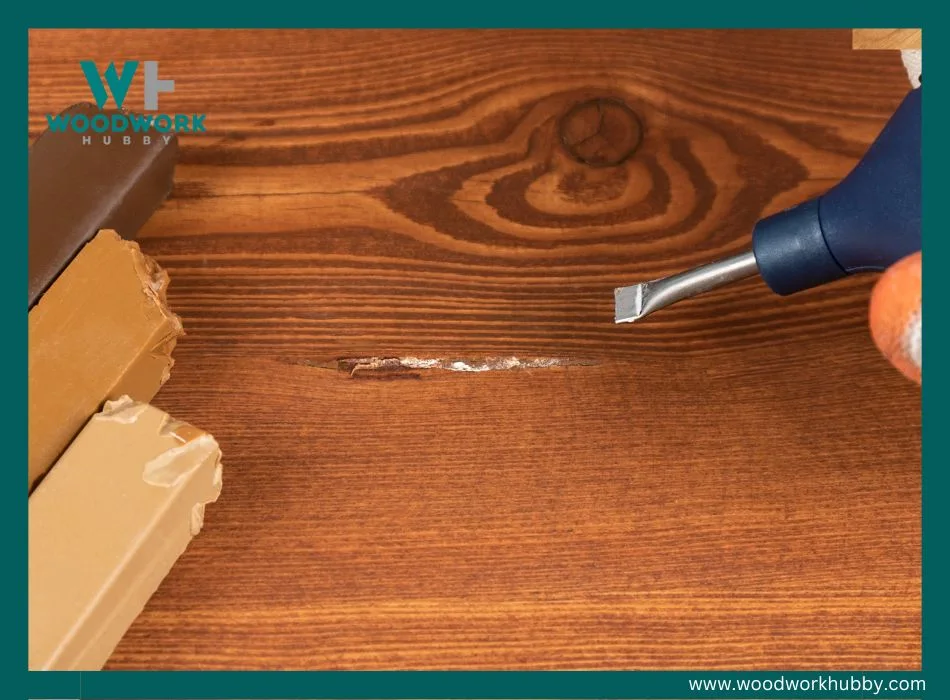
By slowing down the evaporation process, paintable wax can help prevent shrinkage and minimize the risk of splitting or cracking. It’s important to note that this method works best on fresh cuts or recently sawn lumber as it provides an additional protective barrier against moisture loss.
Sealing With Varnish
One effective method to prevent wood from splitting is by sealing it with varnish. Varnish creates a protective barrier on the surface of the wood, reducing moisture evaporation and safeguarding it against cracks.
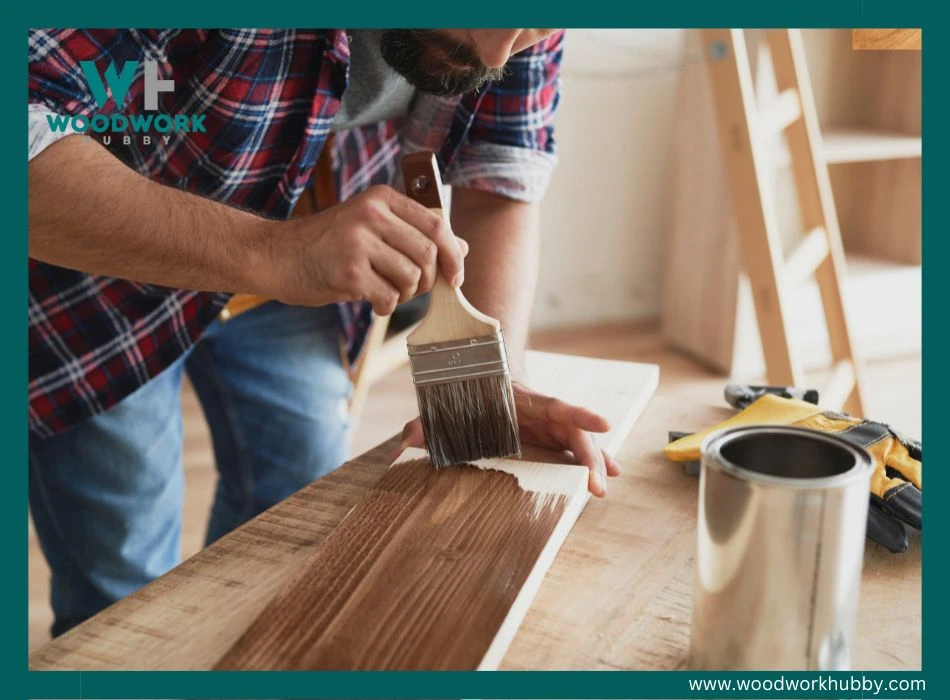
By applying varnish, you can enhance the durability and longevity of your woodwork projects. It’s important to note that before sealing with varnish or any other treatment, make sure to clean the wood surface thoroughly for proper adhesion.
This simple step ensures that the varnish adheres effectively and provides maximum protection for your wood. So when working on your woodworking projects, consider using varnish as an easy yet effective way to keep your wood from splitting.
Treating With Salt Paste
One effective method to prevent the wood from splitting and cracking is to treat it with salt paste. Salt paste works by drawing out excess moisture from the wood, which helps to stabilize its moisture content and reduce the risk of splitting.
To create salt paste, simply mix equal parts of salt and flour with enough water to form a thick paste. Apply the salt paste evenly onto the surface of the wood using a paintbrush or your hands, making sure to cover all exposed areas.
Allow the salt paste to dry completely before wiping off any residue with a clean cloth. The salt in the paste absorbs moisture from within the wood fibers, preventing excessive expansion and contraction that can lead to splitting.
Using Screws Instead Of Nails
When it comes to preventing wood from splitting and cracking, one effective method is to use screws instead of nails. Nails can cause the fibers in the wood to split apart, especially if they are driven too close to the end of the board.

On the other hand, screws provide a stronger hold without causing as much damage. By using screws, you can minimize the risk of splitting and ensure that your woodworking projects remain sturdy and durable for years to come.
Correctly Storing Wood
Properly storing wood is crucial in preventing splitting and cracking. High moisture content can lead to significant damage, so it’s essential to store wood in a cool, dry place with good airflow.
This helps maintain the right balance of moisture and prevents the wood from absorbing excess humidity that could cause swelling and eventual cracking. It’s also important to stack the wood properly, allowing for adequate air circulation between each piece.
Detailed Steps To Apply Different Methods
In this section, we will provide step-by-step instructions for each of the 7 methods to prevent wood from splitting and cracking. Make sure to read on to learn how you can protect your wood projects and furniture effectively.
Steps For Sealing With A Sealant Or Stabilizer
To seal wood and prevent splitting, follow these steps. First, sand the wood surface with fine-grit sandpaper to create a smooth and clean base for the sealant or stabilizer. Next, apply the sealant or stabilizer using a paintbrush, ensuring even coverage across all surfaces of the wood.
Allow it to dry completely according to the product’s instructions before applying additional coats if necessary. Remember to wear protective rubber gloves during this process. Sealing with a sealant or stabilizer can effectively lock in moisture and preserve the integrity of the wood, preventing any future splitting or cracking issues.
Steps For Applying Boiled Linseed Oil
To apply boiled linseed oil to the wood and prevent splitting, I recommend these simple steps.
- First, ensure the wood surface is clean by wiping away any dust or debris.
- Next, using a clean brush or cloth, apply a thin layer of boiled linseed oil evenly over the entire surface of the wood.
- Allow the oil to penetrate into the wood for about 15 minutes before wiping off any excess with a clean cloth.
- Repeat this process two to three more times, allowing each coat to dry completely in between applications.
Boiled linseed oil is an excellent choice for preventing wood splitting because it penetrates deep into the fibers, nourishing and moisturizing them to maintain their flexibility. This helps prevent drying out and shrinkage that can lead to cracks and splits.
Steps For Sealing With Paintable Wax
To seal the wood with paintable wax, start by ensuring that the surface is clean and dry. Then, using a clean brush or cloth, apply a thin layer of the paintable wax evenly across the entire wood surface.
Make sure to follow the grain of the wood for smooth application. Allow the wax to dry completely before applying additional coats if desired. Once dry, lightly sand any rough spots or imperfections with fine-grit sandpaper for a smoother finish.
See my other article on how to fix warped wood
Finally, wipe away any excess wax with a clean cloth and admire your beautifully sealed wood surface. Paintable wax acts as a protective barrier against moisture and helps prevent wood from splitting over time.
Steps For Sealing With Varnish
To seal the wood and protect it from splitting and cracking, applying varnish is an effective method.
Here are the steps I use to seal wood with varnish:
- Start by cleaning the surface of the wood thoroughly using a mild detergent and water solution. This will remove any dirt or debris that may prevent proper adhesion of the varnish.
- Once the wood is clean and dry, use fine-grit sandpaper to gently sand the surface. This helps smooth out any imperfections and provides better adhesion for the varnish.
- After sanding, wipe away any dust using a clean cloth or tack cloth.
- Stir the varnish well before application to ensure it is properly mixed.
- Using a high-quality paintbrush or foam brush, apply a thin coat of varnish on the wood’s surface in long, even strokes following the direction of the grain.
- Allow this initial coat to dry completely according to manufacturer instructions (typically 24 hours).
- Once dry, lightly sand this first coat with fine-grit sandpaper to create a smooth surface for subsequent coats.
- Apply additional coats of varnish as needed, allowing each coat to dry fully before applying another one. Typically, 2-3 coats are sufficient for adequate sealing and protection against splitting and cracking.
Remember that proper ventilation is crucial when working with varnishes due to their strong fumes; always work in a well-ventilated area or wear appropriate respiratory protection if necessary.
Steps For Treating With Salt Paste
To treat wood with salt paste, start by mixing equal parts of table salt and water in a bowl to create a thick paste. Then, using a brush or sponge, apply the salt paste onto the surface of the wood.
Make sure to cover all areas that are prone to splitting or cracking. Allow the salt paste to dry completely for about 24 hours before wiping off any excess with a clean cloth. The salt will help draw out moisture from the wood, reducing its risk of splitting and cracking in the future.
This method is particularly effective for greenwood or freshly cut wood that has a high moisture content. By following these simple steps, you can prevent split wood surfaces and maintain the structural integrity of your wooden projects.”.
Steps For Using Screws Instead Of Nails
When it comes to preventing wood from splitting, using screws instead of nails is a simple yet effective method. To do this, start by pre-drilling pilot holes into the wood, making sure the hole is slightly smaller than the diameter of the screw.
This will help prevent the wood from splitting when you drive in the screws. Once you have drilled the pilot holes, counter-sink them by using a larger drill bit or a countersinking tool.
This ensures that the screw heads are flush with or below the surface of the wood, reducing any stress on the surrounding fibers and minimizing the risk of cracking.
Tips To Prevent Wood From Splitting When Drying
During the drying process, it’s crucial to take precautions to prevent the wood from splitting. Here are some helpful tips to keep in mind:
1. Control the moisture content: High moisture content in green wood is a common cause of splitting and cracking. To minimize this risk, ensure that your wood has been properly air-dried or kiln-dried before use.
2. Slow and steady drying: Rapid changes in moisture can lead to stress and ultimately result in splits and cracks. Try to dry your wood slowly over time, allowing for gradual evaporation and minimizing the chances of damage.
3. Stack with care: When stacking wood for drying, make sure to provide adequate support along the length of each board. This helps distribute any stress evenly and reduces the likelihood of splitting.
4. Avoid direct sunlight: Exposure to direct sunlight during the drying process can cause uneven moisture loss, leading to warping, twisting, and eventually splitting. Opt for shaded areas or cover your stacked lumber with burlap or shade cloth.
5. Use end sealers: Applying an end sealer such as wax or paint on freshly cut ends helps slow down moisture loss from those areas specifically prone to rapid evaporation like end grain surfaces.
6. Maintain proper airflow: Good airflow around your stacked lumber aids in uniform drying by facilitating efficient evaporation of moisture throughout the stack.
By following these essential tips while you’re drying your wood, you’ll significantly reduce the risk of splitting and cracking, allowing you to achieve beautiful results for your woodworking projects!
How To Prevent Wood From Cracking While Drilling
Drilling into wood can be a delicate process, as it’s all too easy to accidentally cause cracks and splits. However, there are several steps you can take to prevent this from happening.
First, make sure you’re using the right drill bit for the job. Read my full guide on selecting the right drill for a pilot hole.
Using a bit that is too large or too dull can exert too much force on the wood, leading to cracks. Additionally, always mark your drilling points beforehand to ensure accuracy and avoid unnecessary pressure.
Next, consider pre-drilling pilot holes before inserting screws or nails. Pilot holes provide a guide for your fasteners and reduce the likelihood of splitting by relieving some of the stress on the surrounding wood fibers.
How To Stop Wood From Splitting When Screwing
When it comes to screwing wood, preventing splitting is essential for maintaining the integrity of your project. One effective method to stop wood from splitting when screwing is by drilling pilot holes before inserting the screws.
This video explains how to stop wood from cracking
By doing this, you create a guide for the screws and reduce stress on the wood fibers, minimizing the risk of splitting. Additionally, using a drill bit slightly smaller than the diameter of your screws ensures a snug fit and prevents excessive pressure on the wood.
How To Prevent Wood Furniture From Cracking
One effective way to prevent wood furniture from cracking is by maintaining a stable environment. Wood tends to expand and contract with changes in humidity, which can lead to cracks over time.
To minimize this risk, it’s important to keep the humidity levels consistent in the room where your furniture is placed. Using a humidifier or dehumidifier can help control moisture levels and prevent excessive drying or swelling of the wood.
Additionally, protecting your wood furniture from direct sunlight is crucial. Ultraviolet rays can cause the wood to fade, crack, and warp over time. Consider placing your furniture away from windows or using curtains or blinds to block out harsh sunlight.

Lastly, avoid subjecting your wooden furniture to extreme temperature changes as this can cause stress on the material leading to cracking. Be mindful of placing hot items directly on wooden surfaces without protective pads or coasters.
How To Repair Cracked Wood
To repair cracked wood, you can fill the cracks with a wood sealer or epoxy for a more durable fix. Another option is to use wood glue mixed with sawdust to create a paste that fills in the cracks seamlessly.
Additionally, you can use wood putty or filler sticks to patch up smaller cracks and imperfections in the wood surface.
I have put together a full guide here on how to prevent cracks in wood from spreading.
Filling With Wood Sealer/epoxy
One effective method to repair cracked wood and prevent further splitting and cracking is by filling the cracks with wood sealer or epoxy. Wood sealer acts as a protective barrier, sealing the cracks and preventing moisture from penetrating the wood fibers, which can lead to further damage.
Epoxy, on the other hand, not only seals the cracks but also provides structural reinforcement to strengthen the damaged area.
Repairing a table with a crack
To fill cracks with wood sealer or epoxy, start by cleaning out any debris or loose particles from the crack using sandpaper or a chisel. Then, apply the wood sealer or epoxy directly into the crack using a paintbrush or putty knife.
Make sure to fill up the entire crack and remove any excess material before it dries.
Using Wood Glue + Sawdust
One effective method to repair cracked wood is by using a mixture of wood glue and sawdust. This DIY alternative to epoxy works well in filling the cracks and restoring the structural integrity of the wood.
To use this method, simply squeeze wood glue into the cracks and sprinkle sawdust over it until an even surface is achieved. Once dry, sand the surface to create a smooth finish. It’s important to note that when choosing the sawdust, make sure it matches the color of your furniture for a seamless repair.
This cost-effective solution can be used for small cracks and is a great option for those who prefer more natural materials in their woodworking projects.
Using Wood Putty Or Filler Sticks
One effective method to prevent wood from splitting is by using wood putty or filler sticks. These products are specifically designed to fill in cracks and small gaps in the wood, providing added strength and stability.
Wood putty or filler sticks come in various colors, allowing you to choose a shade that matches your wooden item or can be stained/painted over. When applying the putty or stick, make sure to press it firmly into the crack or gap until it is completely filled.
Once dried and sanded down, the filled area will blend seamlessly with the surrounding wood, effectively preventing any further splitting. Using wood putty or filler sticks is an easy and affordable solution for maintaining the structural integrity of your wooden pieces.
FAQs
Will Polyurethane Keep Wood From Splitting?
Polyurethane can help prevent the wood from splitting. Polyurethane is a protective finish that forms a hard, durable coating on the surface of the wood.
This coating acts as a barrier, shielding the wood from moisture and temperature changes that can cause it to expand and contract.
By preventing these fluctuations in moisture content, polyurethane helps to reduce the risk of splitting and cracking in the wood. Applying multiple coats of polyurethane and ensuring complete coverage will provide even better protection for your wood projects.
Will Epoxy Stop Wood From Splitting?
Epoxy can effectively stop wood from splitting. Epoxy can be used to fill in splits and cracks in the wood, preventing them from spreading further.
It not only improves the structural integrity of the wood but also helps maintain its natural beauty. By filling these gaps with epoxy, you can prevent moisture from entering and causing further damage.
How To Keep Wood Slices From Splitting
To keep wood slices from splitting, there are a few key steps you can take. First, it’s important to ensure that the wood is properly dried before using it. This will help prevent excessive moisture content and reduce the risk of splitting.
Additionally, applying a sealant or stabilizer can provide an extra layer of protection against drying and shrinkage, helping to maintain the integrity of the wood. Lastly, storing the wood in a cool and dry environment will also contribute to preventing splits in your wood slices.
How To Keep Green Wood From Splitting
Green wood, which has a high moisture content, is particularly prone to splitting and cracking as it dries. To prevent this, one effective method is to seal the ends of the wood with an end sealer or wax.
This helps to slow down the drying process, allowing the moisture in the wood to evaporate evenly and reducing the risk of splitting. Additionally, stacking green wood with spacers between each piece facilitates proper airflow and helps regulate moisture levels for more gradual drying.
Final Thoughts – How To Keep Wood From Splitting
In conclusion, preventing wood from splitting is crucial for maintaining its structural integrity and enhancing its longevity.
By understanding the causes of splitting and cracking, properly storing wood, and utilizing methods such as sealing with a sealant or stabilizer, applying boiled linseed oil, using screws instead of nails, and treating with salt paste, you can effectively protect your wood projects from damage.
Remember to always prioritize moisture control and choose the appropriate method based on the type of woodwork you’re undertaking. With these tips in mind, you can preserve the beauty and functionality of your wooden creations for years to come.
FAQs
1. What causes wood to split?
Wood typically splits due to changes in moisture content and temperature. As the wood dries out or absorbs moisture, it expands and contracts, leading to stress that can result in splitting.
2. How can I prevent the wood from splitting?
To prevent wood from splitting, you can take several measures:
– Seal the ends of freshly cut lumber with a sealant or paint to slow down moisture absorption.
– Use proper drying techniques such as air-drying or kiln-drying before using the wood.
– Avoid exposing the wood to extreme temperature fluctuations.
– Apply a protective finish like varnish or paint to promote stability and reduce moisture exchange.
3. Can I use any type of wood for outdoor projects without worrying about splitting?
While some types of woods are more resistant to splitting than others, all types of woods are susceptible if not properly maintained. However, certain woods like cedar and redwood have natural properties that make them more resistant to splitting when exposed outdoors.
4. Are there any alternative methods for preventing wood from splitting?
Yes, there are alternative methods you can use:
- Using pressure-treated lumber for outdoor projects as they have been treated with chemicals that resist decay and insect infestation.
- Installing metal fasteners instead of nails at critical points where splitting is prone to occur.
- Applying a water-based preservative treatment specifically designed for preventing splits on larger pieces of wooden furniture or structures.
- Remember that prevention is key when it comes to reducing the likelihood of wood splitting over time.

